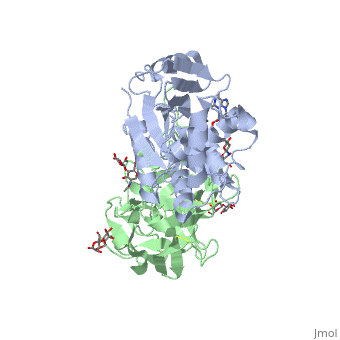From Proteopedia
proteopedia linkproteopedia link |
Ricin
Found inside of the seeds of the castor oil plant and in castor beans, the cytotoxin, Ricin, is known to be one of Earth's most toxic proteins. Ricin was officially discovered in the year 1888 during the investigation of castor seed toxicity, which had been a mystery to scientists since their observations of its effects in the late nineteenth century. German scientist, Peter Hermann Stillmark, was able to extract this compound from the castor seed and purify it into the structure we see today. Originally thought to be used in aiding cancer patients, its highly toxic nature to humans deemed it too dangerous to use in a medical setting. Doctors and scientists have even worked together to pick apart the protein and use each chain in cancer therapy separately. On the other hand, it’s toxicity attracted the attention of criminals, military, and terrorists who came up with the idea of using it as a weapon in bio-terroristic attacks.
Toxicity
We know Ricin to be a very toxic protein based on its interaction with mammals, but in terms of plants, it doesn’t show to have much effect. Due to the cell structure of a plant cell, it contains a cell wall that protects the cell from external threats, including Ricin. Ricin is not able to penetrate the plant cell wall and this is why we see it take on its toxic effects in animal cells instead. When it comes to ricin toxicity in mammals, each species has varying terms of sensitivity to this protein. Some species may experience lethal effects due to Ricin while others deem it a little inconvenience. The severity of Ricin will also depend on the way an individual was exposed to it.
Ricin exposure is very unlikely to be accidental and you shouldn’t worry about getting Ricin Poisoning unless you are consuming pure castor beans. Most cases of Ricin Poisoning are due to the result of mishandling the protein after its extraction to make castor oil. The modes of exposure can range from inhalation to ingestion, excluding dermal absorption. After testing ran on mice, the Ricin protein was determined to be too molecularly large to penetrate the epidermis. Due to its size, it does have detrimental effects when ingested or inhaled. Inhaling this substance is one of the most lethal ways of exposing the body to Ricin, as a lethal dose is roughly only around 5 micrograms per kilogram. In terms of ingestion, the GI tract has mechanisms to degrade this protein after it is consumed. This means that it has a less severe effect than inhalation and its lethal dose comes to about 20 milligrams per kilogram. Severity may also rely on how the Ricin was consumed. Swallowing an entire castor bean results in a reduced risk of ricin poisoning as the shell of the bean is hard to break down. Swallowing crushed seeds is much more toxic than those whose shell is still intact.
Structure
Mechanism of Action
Ricin Poisoning: Symptoms
Ricin Poisoning: Treatment
Ricin’s effect on an organism's body can happen so suddenly and severely that the treatment of ricin poisoning is very variable. Scientists and doctors both recommend that those who may have consistent exposure to ricin and maybe at high risk of being poisoned receive vaccinations to prevent ricin from being able to come in contact with internal cells. It is also highly recommended that worksites that produce castor oil and have high levels of ricin circulating throughout solutions go through very extensive decontamination processes.
If an individual does become poisoned, it is important that their water and blood levels are being monitored and maintained as they are given anti-ricin antibodies to protect the cells. This can extend survival time and even help the organism to fight off the ricin completely.
|
References
[1]Audi J, Belson M, Patel M, Schier J, Osterloh J. Ricin Poisoning: A Comprehensive Review. JAMA. 2005;294(18):2342–2351. doi:10.1001/jama.294.18.2342
[2]Etimad, L., Moshiri, M., & Hamid, F. (2019, June 6). Ricin: An ancient story for a timeless plant toxin. RBMB. Retrieved April 23, 2022, from https://www.ncbi.nlm.nih.gov/pmc/articles/PMC6628454/#sec2-toxins-11-00324title
[3]Gal, Y., Mazor, O., Falach, R., Sapoznikov, A., Kronman, C., & Sabo, T. (2017). Treatments for Pulmonary Ricin Intoxication: Current Aspects and Future Prospects. Toxins, 9(10). https://doi-org.proxy.library.maryville.edu/10.3390/toxins910031
[4]Tumer, N. E. (2019). Introduction to the Toxins Special Issue “Ricin Toxins.” Toxins, 12(1). https://doi-org.proxy.library.maryville.edu/10.3390/toxins12010013/

